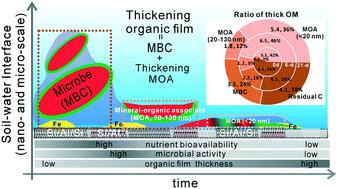当前位置:
X-MOL 学术
›
Environ. Sci.: Nano
›
论文详情
Our official English website, www.x-mol.net, welcomes your feedback! (Note: you will need to create a separate account there.)
Direct evidence for thickening nanoscale organic films at soil biogeochemical interfaces and its relevance to organic matter preservation
Environmental Science: Nano ( IF 7.3 ) Pub Date : 2020-07-31 , DOI: 10.1039/d0en00489h Xizhi Huang 1, 2, 3, 4, 5 , Yiwei Li 1, 2, 3, 4, 5 , Georg Guggenberger 6, 7, 8, 9, 10 , Yakov Kuzyakov 6, 7, 8, 9, 10 , Bi-Feng Liu 1, 2, 3, 4, 5 , Jinshui Wu 6, 7, 8, 9, 10
Environmental Science: Nano ( IF 7.3 ) Pub Date : 2020-07-31 , DOI: 10.1039/d0en00489h Xizhi Huang 1, 2, 3, 4, 5 , Yiwei Li 1, 2, 3, 4, 5 , Georg Guggenberger 6, 7, 8, 9, 10 , Yakov Kuzyakov 6, 7, 8, 9, 10 , Bi-Feng Liu 1, 2, 3, 4, 5 , Jinshui Wu 6, 7, 8, 9, 10
Affiliation

|
The emerging consensus on organic matter (OM) cycling in soil and sediment proposes that a continuum of biological and geochemical processes in the micro-environment controls the fate of OM. However, spatio-temporal observation of the biogeochemical nature and behaviour of OM at the soil–water interfaces (SWIs) is impeded by the heterogonous and opaque nature of their microenvironment. Herein, we used a novel SoilChip method (soil microarrays incubated with a predefined solution) to continuously mimic and trace the OM biogeochemistry at SWIs for 21 days. Combining X-ray photoelectron spectroscopy and ion sputtering on SoilChips, we provided the first direct evidence that a nanoscale organic film with a distinct composition and thickness gradually formed at the SWI within 21 days of cultivation. Although the OM coating on the SWI quickly reached equilibrium within 4 days, the formation of thicker mineral–organic association (MOA, 20–130 nm) and microbial biomass (>130 nm) continued, partially at the cost of the thin MOA (<20 nm). Consistent with the thickening SWI, the bioavailability of nutrients (dissolved organic C and ammonium) decreased gradually over 21 days, which restrained the microbial activities. Collectively, thickening SWIs act as a biogeochemical gate to regulate the bioavailability of specific organic compounds and determine their preservation or microbial mineralization. Further, thickening SWIs in the z-axis direction provide direct structural insight to increase carbon sequestration in soil and sediment.
中文翻译:

在土壤生物地球化学界面上增厚纳米级有机膜的直接证据及其与有机物保存的关系
关于土壤和沉积物中有机物(OM)循环的新兴共识表明,微环境中生物和地球化学过程的连续性控制着OM的命运。然而,时空观测的OM在土壤-水界面(SWI)的生物地球化学性质和行为受到其微环境的异质和不透明性质的阻碍。在本文中,我们使用了一种新颖的SoilChip方法(将土壤微阵列与预定溶液孵育)以连续21天连续模拟和追踪OM生物地球化学。将X射线光电子能谱和离子溅射结合在SoilChips上,我们提供了第一个直接证据,表明在培养21天之内在SWI上逐渐形成了具有独特成分和厚度的纳米级有机膜。尽管SWI上的OM涂层在4天内迅速达到平衡,但继续形成较厚的矿物-有机缔合(MOA,20-130 nm)和微生物生物量(> 130 nm),部分是以薄MOA(< 20 nm)。与SWI增稠一致,养分(溶解的有机碳和铵)的生物利用度在21天之内逐渐下降,这限制了微生物的活动。总的来说,增稠的SWI充当生物地球化学的大门,以调节特定有机化合物的生物利用度并确定其保存或微生物矿化。此外,在 与SWI增稠一致,养分(溶解的有机碳和铵)的生物利用度在21天之内逐渐下降,这限制了微生物的活动。总的来说,增稠的SWI充当生物地球化学的大门,以调节特定有机化合物的生物利用度并确定其保存或微生物矿化。此外,在 与SWI增稠一致,养分(溶解的有机碳和铵)的生物利用度在21天之内逐渐下降,这限制了微生物的活动。总的来说,增稠的SWI充当生物地球化学的大门,以调节特定有机化合物的生物利用度并确定其保存或微生物矿化。此外,在z轴方向提供直接的结构见解,以增加土壤和沉积物中的碳固存。
更新日期:2020-09-18
中文翻译:

在土壤生物地球化学界面上增厚纳米级有机膜的直接证据及其与有机物保存的关系
关于土壤和沉积物中有机物(OM)循环的新兴共识表明,微环境中生物和地球化学过程的连续性控制着OM的命运。然而,时空观测的OM在土壤-水界面(SWI)的生物地球化学性质和行为受到其微环境的异质和不透明性质的阻碍。在本文中,我们使用了一种新颖的SoilChip方法(将土壤微阵列与预定溶液孵育)以连续21天连续模拟和追踪OM生物地球化学。将X射线光电子能谱和离子溅射结合在SoilChips上,我们提供了第一个直接证据,表明在培养21天之内在SWI上逐渐形成了具有独特成分和厚度的纳米级有机膜。尽管SWI上的OM涂层在4天内迅速达到平衡,但继续形成较厚的矿物-有机缔合(MOA,20-130 nm)和微生物生物量(> 130 nm),部分是以薄MOA(< 20 nm)。与SWI增稠一致,养分(溶解的有机碳和铵)的生物利用度在21天之内逐渐下降,这限制了微生物的活动。总的来说,增稠的SWI充当生物地球化学的大门,以调节特定有机化合物的生物利用度并确定其保存或微生物矿化。此外,在 与SWI增稠一致,养分(溶解的有机碳和铵)的生物利用度在21天之内逐渐下降,这限制了微生物的活动。总的来说,增稠的SWI充当生物地球化学的大门,以调节特定有机化合物的生物利用度并确定其保存或微生物矿化。此外,在 与SWI增稠一致,养分(溶解的有机碳和铵)的生物利用度在21天之内逐渐下降,这限制了微生物的活动。总的来说,增稠的SWI充当生物地球化学的大门,以调节特定有机化合物的生物利用度并确定其保存或微生物矿化。此外,在z轴方向提供直接的结构见解,以增加土壤和沉积物中的碳固存。



























 京公网安备 11010802027423号
京公网安备 11010802027423号